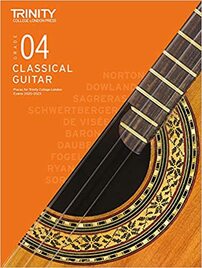Grade 4
|
Musical Knowledge
These questions test the candidate’s understanding of their chosen pieces, the context of their performance and their knowledge of their instrument and its technical demands, including best practice for rehearsal and performance. Five questions, each worth 2 marks, will normally be asked. Questions will include discussions on most of the areas mentioned below, but not all parameters will be relevant to all disciplines and pieces, and examiners will select questions as appropriate. Grade 4 As for previous grades, and additionally:
|
Grade 4 pieces - tutor performances (2020-23)
Grade 4 pieces - tutor performances (2016-19)
|
Andantino by Ferdindo Carulli (group A) SLOW PRACTICE
|
Andantino by Ferdindo Carulli (group A)
|
|
|
|
|
Milonga by Juan Antonio Muro (group B) SLOW PRACTICE
|
Milonga by Juan Antonio Muro (group B)
|
|
|
|
|
Night Piece
by Peter Nuttall & John Whitworth (group B) SLOW PRACTICE |
Night Piece
by Peter Nuttall & John Whitworth (group B) |
|
|
|
Grade 4 technical exercise and 3 studies
|
|
|
|
|
|
Music Knowledge Questions
MILONGA
KEY = A minor
no key signature
Tonic A minor - A C E
Dominant is E major - E G# B
Technical challenge: playing the slurs accurately in time - practice with slurred scales and slur studies (pieces that are made up of a lot of slurs)
ON JOE’S DECK
KEY = G major
1 sharp in key signature
Tonic G major - G B D
Dominant is D major - D F# A
Technical challenge: the chord at bar 12. It is a big leap - practice with chord studies (pieces that are made up a lot of chords)
Modulation to closely related keys: - BAR 9 to E minor (relative minor)
[E minor=E G B.
B major B D# F# is dominant of E minor]
ANDANTINO
KEY = A minor
no key signature
Tonic A minor - A C E
Dominant is E major - E G# B
Technical challenge: chords at bar 8. Every finger has to change string and fret - practice with other chord studies (pieces that are made up a lot of chords)
Modulation to closely related keys: - BAR 11 to C major (relative major)
[C major=C E G.
G major G B D is dominant of C major]
INTERVALS
minor 2nd - one semitone ie. B to C, E to F, C to C sharp etc
major 2nd - two semitones ie. B to C#, E to F#, C to D etc
minor 3rd - three semitones ie. B to D, E to G, C to D# etc
major 3rd - four semitones ie. B to D#, E to G#, C to E etc
perfect 4th - five semitones ie. B to E, E to A, C to F etc
augmented 4th (or diminished 5th) - six semitones B to F, E to A#, C to F#
perfect 5th - seven semitones ie. B to F#, E to B, C to G etc
minor 6th - eight semitones ie. B to G, E to C, C to G# etc
major 6th - nine semitones ie. B to G#, E to C#, C to A etc
minor 7th - ten semitones ie. B to A, E to D, C to A# etc
major 7th - eleven semitones ie. B to Asharp, E to D#, C to B etc
MILONGA
KEY = A minor
no key signature
Tonic A minor - A C E
Dominant is E major - E G# B
Technical challenge: playing the slurs accurately in time - practice with slurred scales and slur studies (pieces that are made up of a lot of slurs)
ON JOE’S DECK
KEY = G major
1 sharp in key signature
Tonic G major - G B D
Dominant is D major - D F# A
Technical challenge: the chord at bar 12. It is a big leap - practice with chord studies (pieces that are made up a lot of chords)
Modulation to closely related keys: - BAR 9 to E minor (relative minor)
[E minor=E G B.
B major B D# F# is dominant of E minor]
ANDANTINO
KEY = A minor
no key signature
Tonic A minor - A C E
Dominant is E major - E G# B
Technical challenge: chords at bar 8. Every finger has to change string and fret - practice with other chord studies (pieces that are made up a lot of chords)
Modulation to closely related keys: - BAR 11 to C major (relative major)
[C major=C E G.
G major G B D is dominant of C major]
INTERVALS
minor 2nd - one semitone ie. B to C, E to F, C to C sharp etc
major 2nd - two semitones ie. B to C#, E to F#, C to D etc
minor 3rd - three semitones ie. B to D, E to G, C to D# etc
major 3rd - four semitones ie. B to D#, E to G#, C to E etc
perfect 4th - five semitones ie. B to E, E to A, C to F etc
augmented 4th (or diminished 5th) - six semitones B to F, E to A#, C to F#
perfect 5th - seven semitones ie. B to F#, E to B, C to G etc
minor 6th - eight semitones ie. B to G, E to C, C to G# etc
major 6th - nine semitones ie. B to G#, E to C#, C to A etc
minor 7th - ten semitones ie. B to A, E to D, C to A# etc
major 7th - eleven semitones ie. B to Asharp, E to D#, C to B etc
